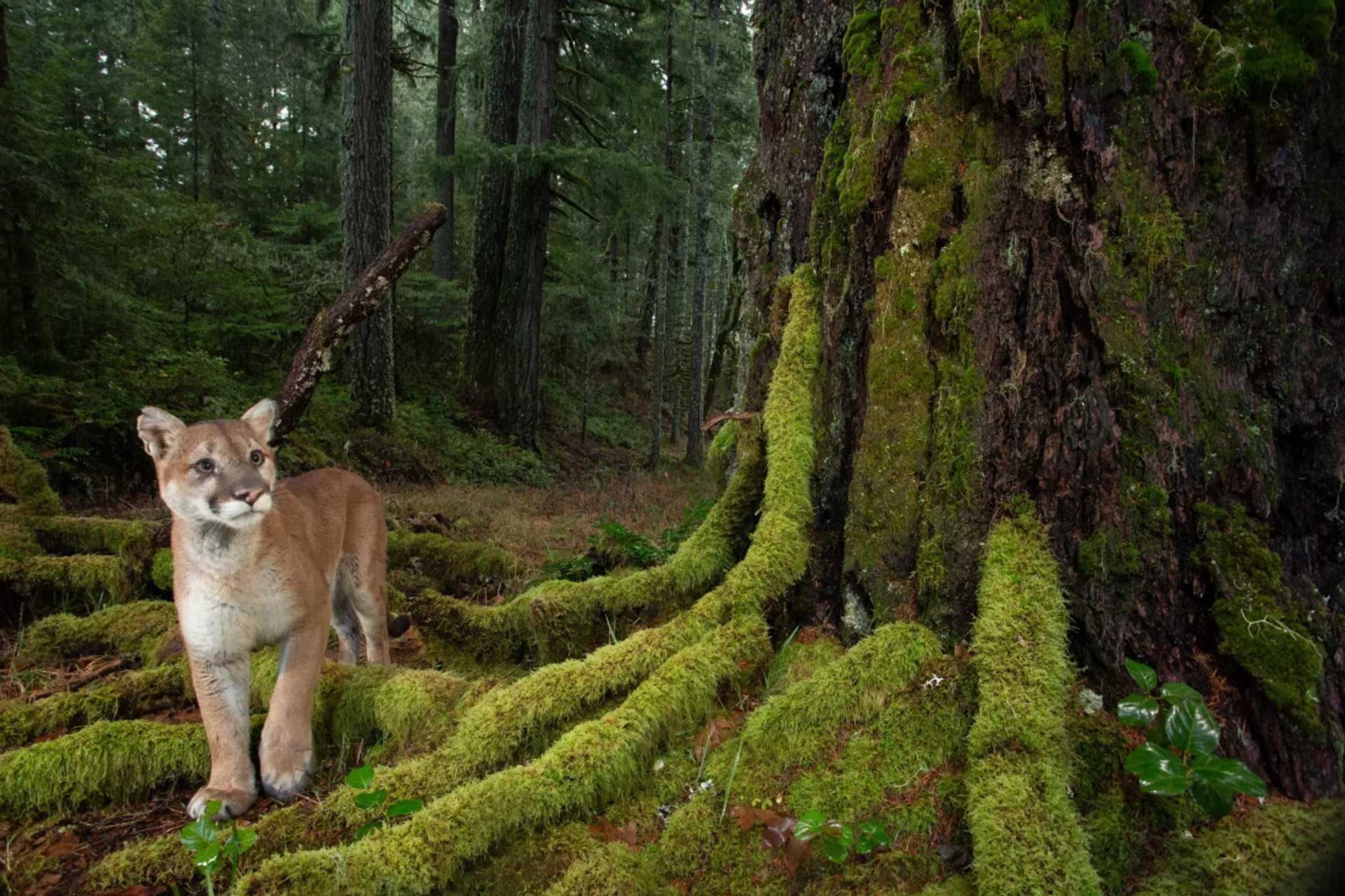 From mosses to mountain lions, the temperate old-growth rainforests of the Pacific Northwest provide the complexities and conditions necessary to support high levels of biodiversity. The Northwest Forest Plan has provided protection for these ancient ecosystems over the last 30 years and has helped advance forest management in Oregon, Washington and California. Developed in response to decades of unsustainable logging practices, the plan has helped restore forest ecosystems in 17 national forests.
From mosses to mountain lions, the temperate old-growth rainforests of the Pacific Northwest provide the complexities and conditions necessary to support high levels of biodiversity. The Northwest Forest Plan has provided protection for these ancient ecosystems over the last 30 years and has helped advance forest management in Oregon, Washington and California. Developed in response to decades of unsustainable logging practices, the plan has helped restore forest ecosystems in 17 national forests.
“As humans, our everyday lives are sustained by the behaviors and interactions of forest organisms,” photographer David Herasimtschuk writes of old growth forests. “Yet, because these processes and relationships occur in places and at scales rarely observed, our connection with forest biodiversity and the role it plays in nurturing our well-being often goes completely unnoticed.”
In the last 10 years, Herasimtschuk has photographed forests across the Pacific Northwest, documenting the inhabitants of these last remaining old-growth ecosystems. From salamanders and salmon to bears and mountain lions, his images illustrate not only the beauty of the forests and their creatures but the symbiotic relationships which are vital to the forests’ health and the planet’s welfare.
We interviewed Herasimtschuk about his efforts to educate people about the importance of preserving these ancient forests. The interview has been edited for clarity and length.
 A group of pink salmon return home to the waters where they were born, bringing with them a pulse of nutrients that helps drive stream and forest ecosystems. From old-growth trees to aquatic insects, hundreds of species rely on the large amount of marine-derived nutrients that salmon provide. As salmon numbers have declined throughout the Pacific Northwest, this important ecological resource has been lost from many forest and river environments in the region. It's now estimated that only 3-7% of the nutrients salmon deliver make it back into freshwater environments.
A group of pink salmon return home to the waters where they were born, bringing with them a pulse of nutrients that helps drive stream and forest ecosystems. From old-growth trees to aquatic insects, hundreds of species rely on the large amount of marine-derived nutrients that salmon provide. As salmon numbers have declined throughout the Pacific Northwest, this important ecological resource has been lost from many forest and river environments in the region. It's now estimated that only 3-7% of the nutrients salmon deliver make it back into freshwater environments.
What motivates you to photograph old-growth forests?
Protecting intact, mature and old-growth forests worldwide has been found to be one of the most immediate and cost-effective solutions to mitigating the impacts of climate change, yet adequate policy to manage these forests for ecosystem health and carbon storage has been limited.
The temperate rainforests of western North America have the highest carbon storage potential of any forest type in the world and are recognized as some of the most valuable ecosystems on the planet. Yet, conflicts over these forests have been ongoing since the 1980s, with the timber industry and conservation community battling over how they are managed.
Celebrating the beauty and importance of these environments, this photo essay is a present-day look at the complex connections we share with these forests. Currently, there are numerous proposed policy initiatives that are focused on creating a new framework for forest health and old-growth protection in the Pacific Northwest. This includes a movement to protect mature forests, which are made up of trees that are 80-150 years old and viewed as comprising the next generations of old-growth forests.
These legislative actions also contain policy to update and rethink how private and state forests are managed in the state of Oregon, as well as work to modernize forest protection on federal lands nationwide. In an effort to advance our country’s climate initiatives, the Biden administration enacted an executive order in 2022 that committed the federal government to protecting the few remaining mature and old-growth forests we have left. In response to that order, the U.S. Forest Service plans to make major revisions to both the National Forest Plan and Northwest Forest Plan this year.
With many decisions currently being discussed about the fate of our forests in the Pacific Northwest, it's important that the public and decision-makers understand how healthy forests function, and have the information they need to make science-based decisions in regard to forest management.
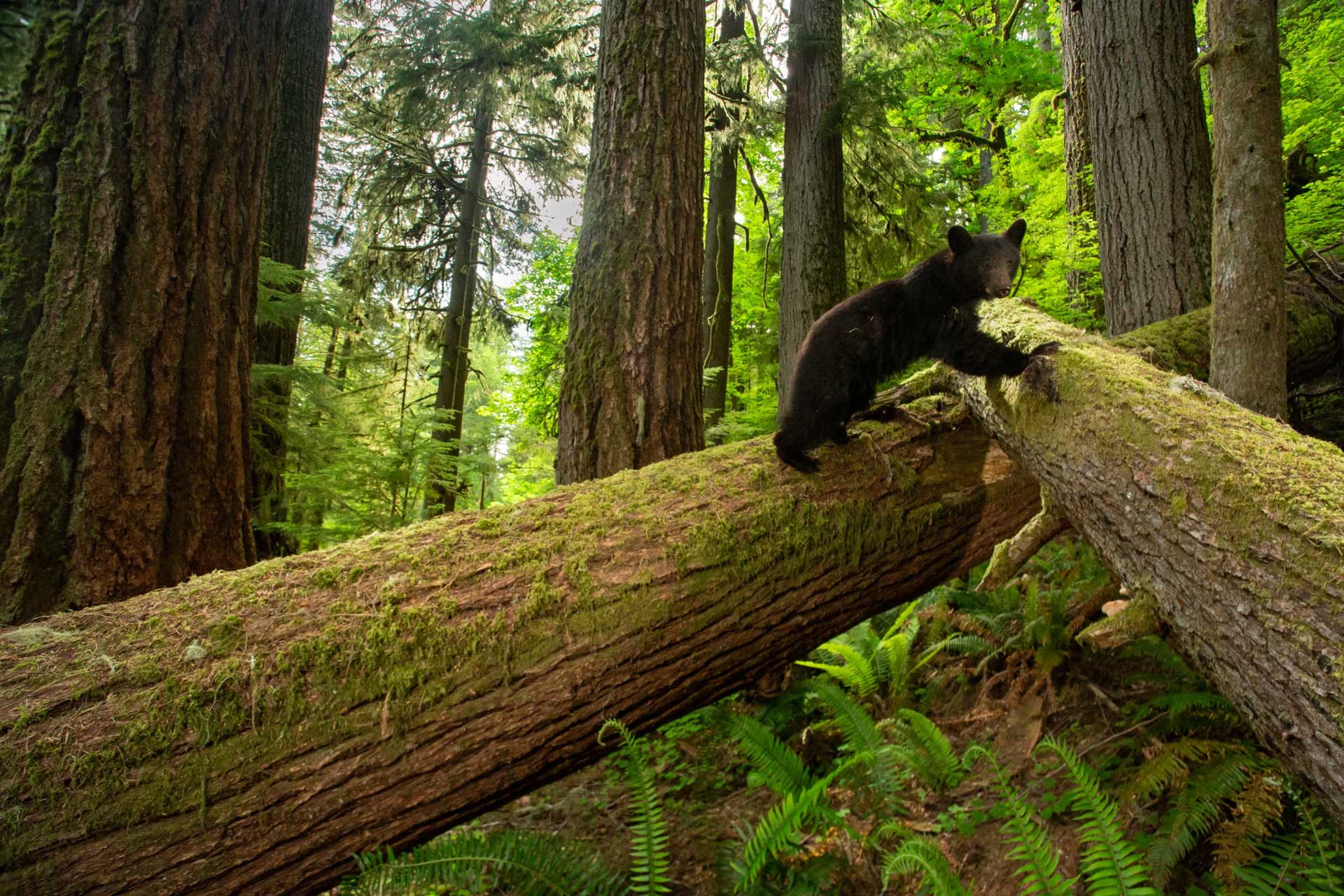 Climbing through an understory of fallen Douglas firs, a young black bear explores an old-growth forest in Oregon’s Coast Range. Researchers are finding that fallen trees, also known as “dead wood,” play an important role in forest ecosystems and influence everything from moisture and carbon storage to providing habitat for a number of species.
Climbing through an understory of fallen Douglas firs, a young black bear explores an old-growth forest in Oregon’s Coast Range. Researchers are finding that fallen trees, also known as “dead wood,” play an important role in forest ecosystems and influence everything from moisture and carbon storage to providing habitat for a number of species.
How long have you been working on this project?
I have been working, living and exploring in the Pacific Northwest since 2011, and started this old-growth focused project in 2022.
What kinds of images were you hoping to capture with your work?
From the top of the canopy to the waters below, my goal for this project is to create a series of photos that provide an entire ecosystem aesthetic. To do this, I work to create wide-angle images that put a species, or human, in context of the forest or habitat type.
Currently, a large amount of my work focuses on the connections between forests, rivers and fish. In the Pacific Northwest, the relationship between salmon and forests embodies a sense of connection that seems almost mystical. Delivering a pulse of nutrients, returning adult salmon nourish some of the largest trees in the world, and in return, these ancient forests provide a foundation for the complexity of conditions that salmon and other fish rely on. For millions of years, salmon, trout and numerous other aquatic species have adapted to the conditions created by these massive trees. From bank stabilization and water filtration to the creation of cover and spawning habitat, large trees provide a multitude of ecosystem services for aquatic environments.
To illustrate these relationships, or to show how these connections have been lost, I work to find opportunities where I can put fish and forests in the same image. This type of image often helps share the story of how forest management plays a critical role in salmon conservation.
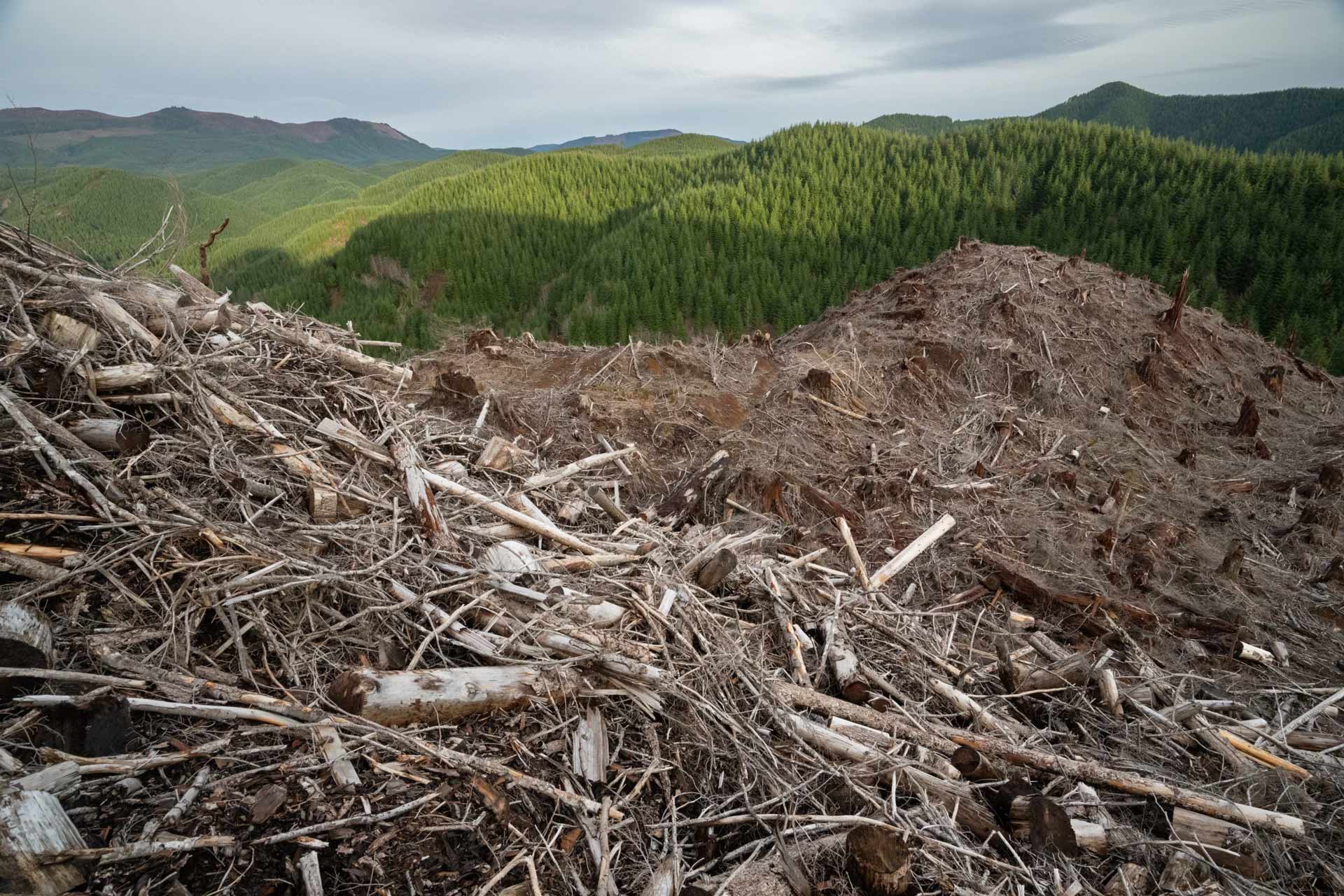 A clear-cut forest in Oregon’s Coast Range Forest. Recent research and analysis has shown that industrial logging practices impact both water quality and quantity. In Oregon’s Coast Range, stream flow was found to decrease by 50% on tree plantations that were cut on 40- to 50-year rotations.
A clear-cut forest in Oregon’s Coast Range Forest. Recent research and analysis has shown that industrial logging practices impact both water quality and quantity. In Oregon’s Coast Range, stream flow was found to decrease by 50% on tree plantations that were cut on 40- to 50-year rotations.
What have you learned about the forest’s ecosystem since you’ve started this project?
One of the most important concepts I’ve come to understand while working on this project is that not all forests are equal. How we manage a forest can have huge repercussions that impact numerous species and processes, and can often lead to changes in ecosystem services that humans rely on.
Historically, the idea of old-growth forests as important natural systems was not the dominant perspective in our society. These ancient trees were once considered crops and perceived as “biological deserts.” Industrial logging in the 20th century removed most of the old growth, resulting in the younger forests we experience today. While some areas on federal land have been protected, allowing forests to regrow, there have also been large tracts of private land that are now managed for timber, and are cut every 50-80 years to meet the demand for timber.
Over the last 50 years, science has been working to understand how these impacts have changed forest ecosystems in the region. Beyond carbon sequestration, scientists are finding these environments play an important role in a multitude of ecosystem services, including water quantity and quality, and that management decisions can greatly impact these processes.
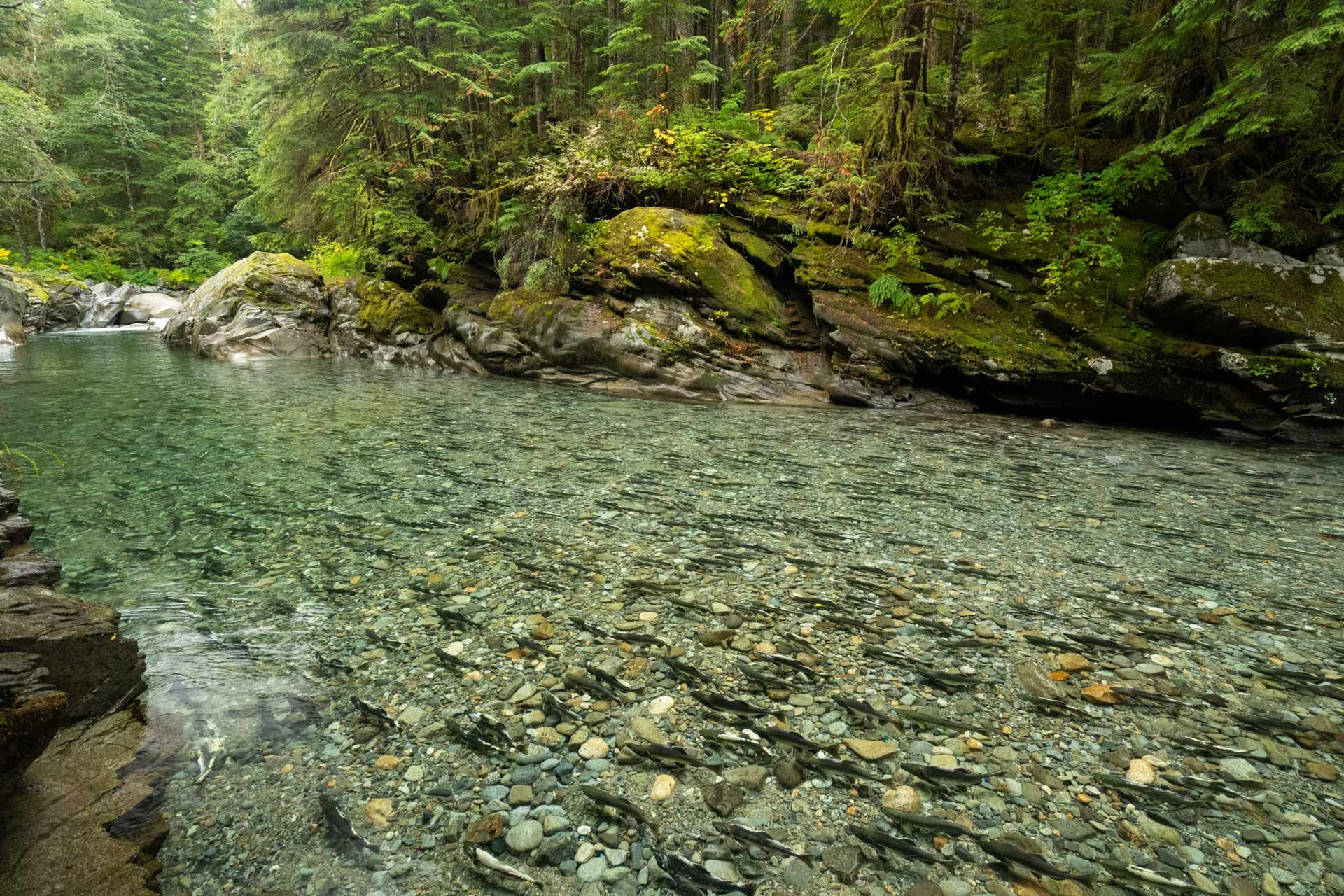 In the Pacific Northwest, it’s becoming increasingly difficult to experience large salmon runs that are similar to what was seen historically. The forests of the Pacific Northwest have some of the highest carbon storage potential of any forest type in the world. With certain tree species' ability to grow up to three times faster when supported by the nutrients salmon bring to a forest's ecosystem, it's believed that salmon restoration could be an important tool to help increase a forest’s ability to sequester carbon in the region.
In the Pacific Northwest, it’s becoming increasingly difficult to experience large salmon runs that are similar to what was seen historically. The forests of the Pacific Northwest have some of the highest carbon storage potential of any forest type in the world. With certain tree species' ability to grow up to three times faster when supported by the nutrients salmon bring to a forest's ecosystem, it's believed that salmon restoration could be an important tool to help increase a forest’s ability to sequester carbon in the region.
What have you learned that’s surprised you?
Looking beyond their physical beauty, scientists are discovering that old-growth forests are home to a network of almost unfathomable connections that showcase the importance and complexity of regions biodiversity. One of the greatest examples is the relationship between salmon and trees. Salmon are fundamental to the health of forest ecosystems in the Pacific Northwest. As they return home to spawn and die, they bring with them a large pulse of nutrients that helps drive stream and forest ecosystems. By absorbing the nutrients from decaying fish, researchers have found that salmon actually provide nitrogen to trees, which is a limited nutrient in forest ecosystems. It’s even been discovered that certain tree species can grow up to three times faster when influenced by salmon. As populations of these vital fish continue to decline throughout the Pacific Northwest, scientists worry that trees and forests no longer receive nutrients they need to reach their full ecological potential.
Beyond the salmon and trees, some of the largest surprises in these forests come from some of the smallest species, like salamanders. Due to the cryptic nature of these amphibians, it's hard to grasp their true importance within an ecosystem, but recent research has demonstrated that these amphibians play an important role in the global carbon cycle.
In Northern California, scientists have revealed that, by hunting and preying on insects that spend their lives ripping, shredding and feeding on leaves — a behavior that actually releases carbon dioxide into the atmosphere — salamanders effectively prevent this carbon from entering the atmosphere and allow it to stay locked in leaves and on the forest floor.
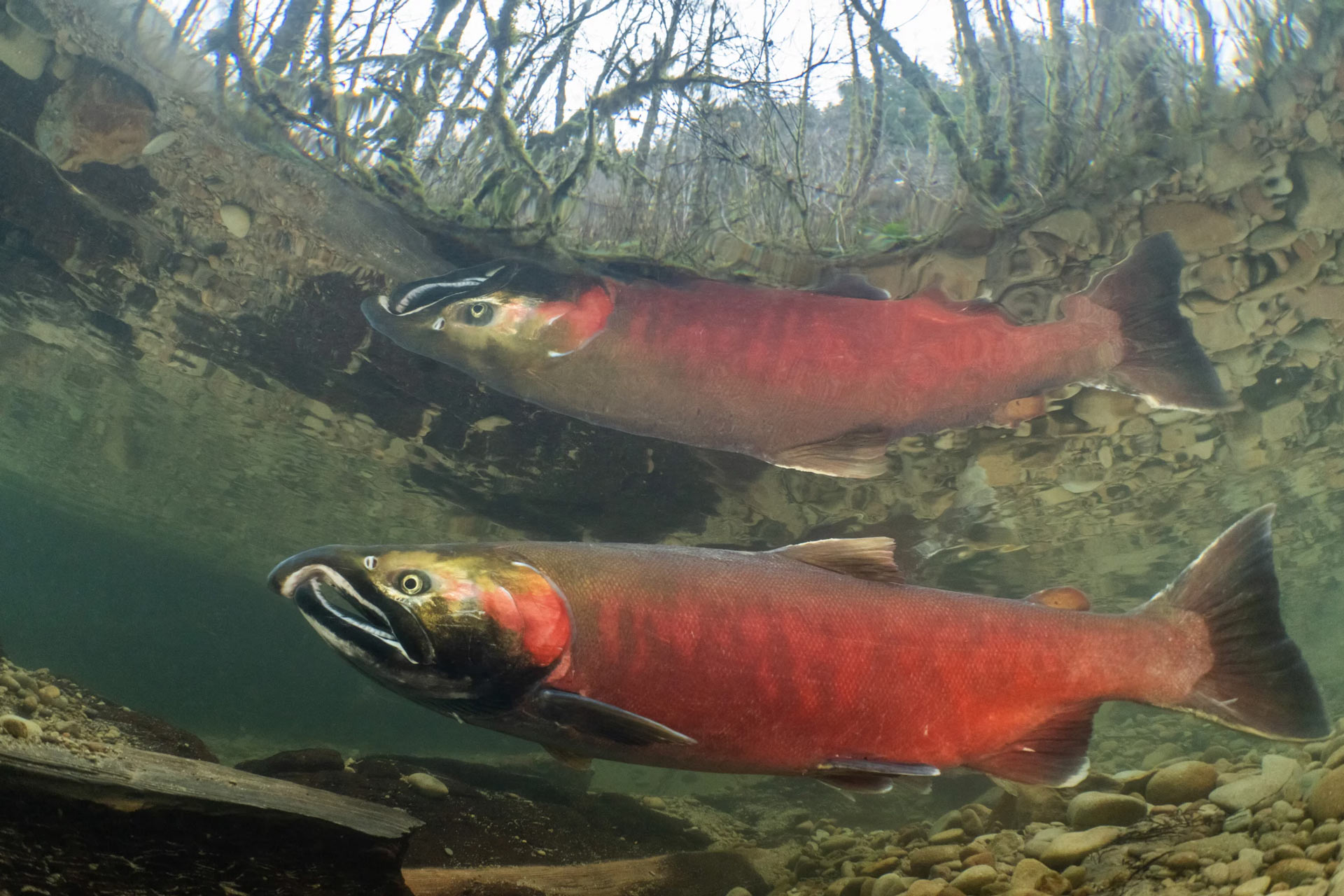 A male coho salmon migrates to its spawning waters in a small creek in Oregon’s Coast Range. Over a century of commercial logging has removed most of the old-growth trees from the region, resulting in riparian forests that are made up of much smaller trees. This lack of larger trees has had a major impact on forest and river ecosystems in the Northwest and remains as a major factor limiting in the conservation of federally protected fish, like coho salmon.
A male coho salmon migrates to its spawning waters in a small creek in Oregon’s Coast Range. Over a century of commercial logging has removed most of the old-growth trees from the region, resulting in riparian forests that are made up of much smaller trees. This lack of larger trees has had a major impact on forest and river ecosystems in the Northwest and remains as a major factor limiting in the conservation of federally protected fish, like coho salmon.
What is your process for documenting the wildlife in the forest? Do you need special equipment?
Working and photographing in old-growth forests definitely comes with a unique set of challenges, and through trial and error, I’ve been able to develop methods that work relatively well in these environments. Documenting these forests from an ecosystem perspective often means I need a wide range of gear. This includes everything from underwater housings and drysuits to document fish, to camera traps to photograph large mammals like bears.
For me, personally, I also really enjoy the process and exploration that goes into the creation of each photograph. For each image, this often results in many miles hiked, and snorkeled, to learn the best locations and approaches to photograph different species. Most days aren’t a great success, photographically speaking, but I love being in the forest, and with each outing, I feel like I learn a little more.
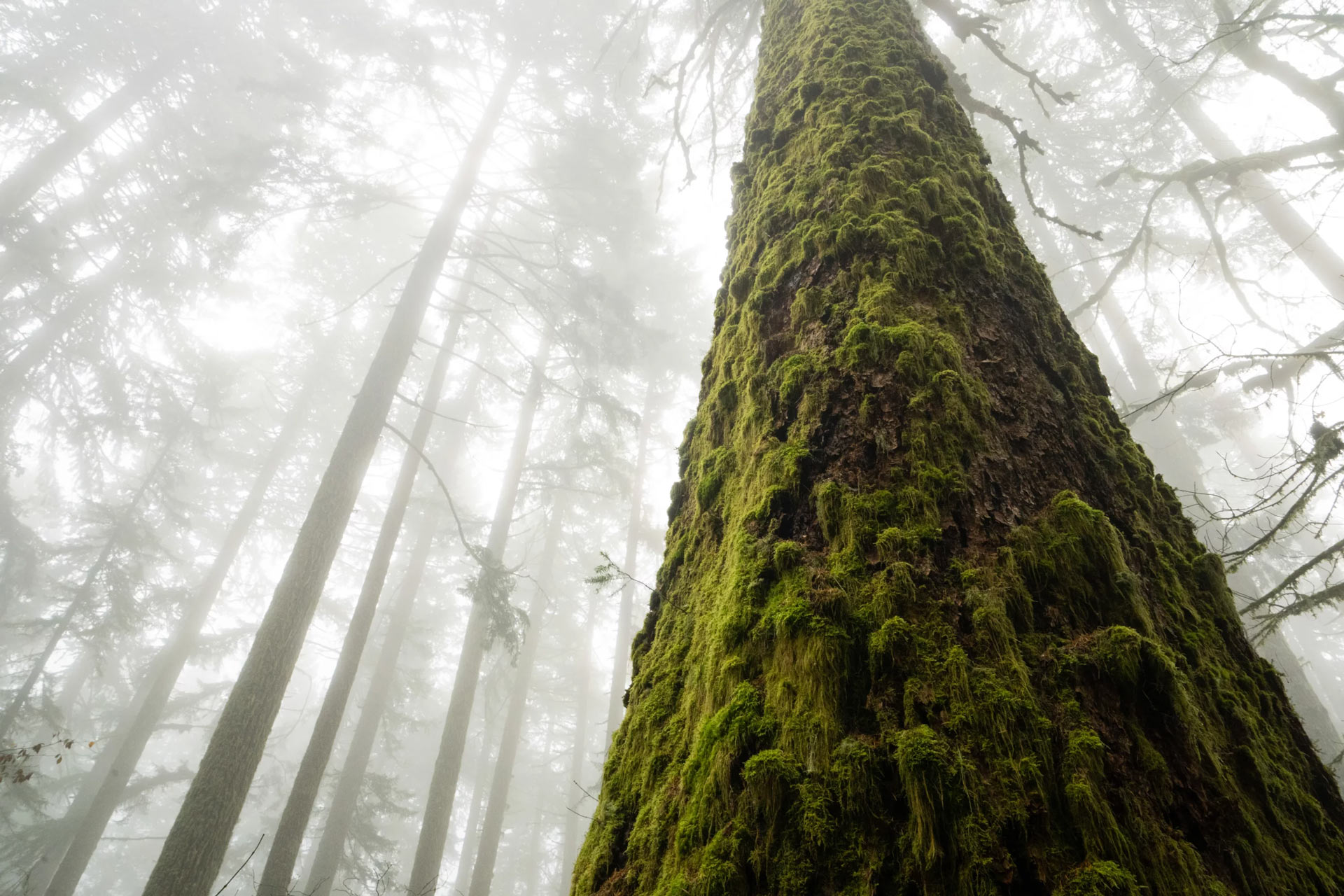 A giant Douglas Fir disappears into the fog in Oregon’s Coast Range. The temperate rainforests of western Oregon have some of the highest potential to capture carbon of any forest type in the world, storing an average of 1,127 metric tons per hectare.
A giant Douglas Fir disappears into the fog in Oregon’s Coast Range. The temperate rainforests of western Oregon have some of the highest potential to capture carbon of any forest type in the world, storing an average of 1,127 metric tons per hectare.
Do you work with scientists studying forest ecosystems? If so, how does that collaboration work?
Working at the confluence of science, conservation and storytelling, I’ve been fortunate to collaborate with many passionate scientists working at the forefront of forest ecology. Much of the imagery created for this project has been guided and inspired by the research and science from H.J. Andrews Experimental Forest, a forest co-managed by the U.S. Forest Service and Oregon State University. Tucked in the Cascade Mountain Range in western Oregon, this long-term ecological research site is one of the most studied old-growth ecosystems on the planet and has laid the foundation for forest science, understanding and policy worldwide.
As we move forward in our approach to address climate change, finding engaging and novel ways to communicate science becomes more important than ever. Working closely with the researchers who are uncovering the importance and mysteries of our natural world, this project focuses on creating imagery that sparks curiosity and helps celebrate the interactions and relationships in nature that are difficult to see.
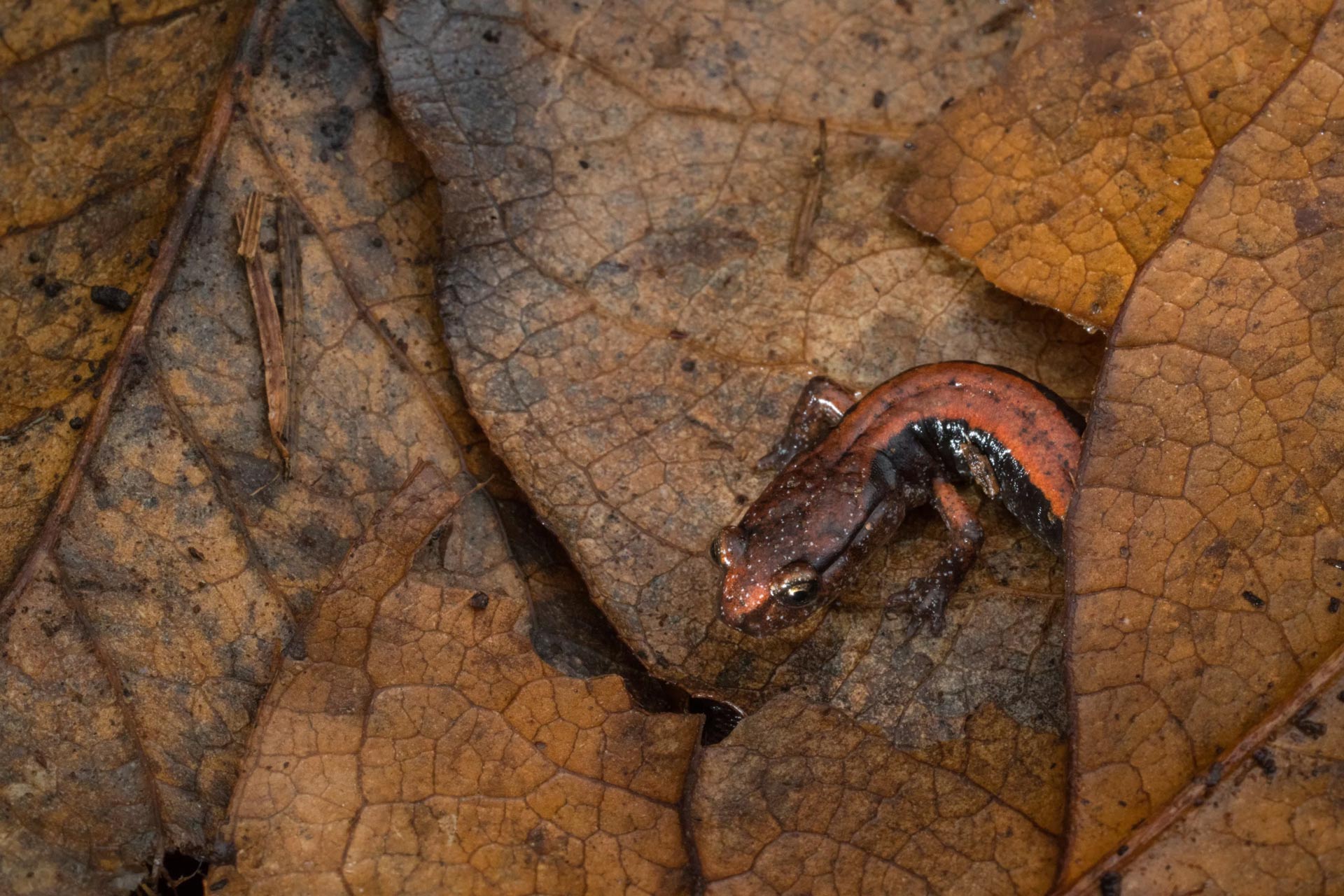 A western red-backed salamander navigates the understory leaf litter in a mature forest in Oregon’s Coast Range. Researchers in the Northwest have found that woodland salamanders actually play an important role in carbon storage by feeding on invertebrates that release carbon.
A western red-backed salamander navigates the understory leaf litter in a mature forest in Oregon’s Coast Range. Researchers in the Northwest have found that woodland salamanders actually play an important role in carbon storage by feeding on invertebrates that release carbon.
What are some of your favorite images?
I think some of my favorite images so far for this project have been the ones created using camera traps. Communicating the size of old-growth trees is often difficult, so it’s helpful to have a subject in the image to convey scale. Few species symbolize wild environments better than mountain lions and bears, so to be able to create images of these elusive predators as they explore their old-growth habitats is truly special.
Creating a useful image with a camera trap can often take months of work and fine-tuning, and even then, it’s rare to get the shot you hoped for. The cameras sit in the forests for long periods of time, exposed to the elements and curious wildlife. It’s not uncommon to return to a trap to find it has been dismantled by a bear or knocked over from falling trees and branches.
Yet, with a little luck and a lot of persistence, every now and then you create a photo where all the elements come together. These unique photos provide an intimate perspective of these environments that few have ever seen, making them a valuable tool to help teach audiences about the importance of these forests.
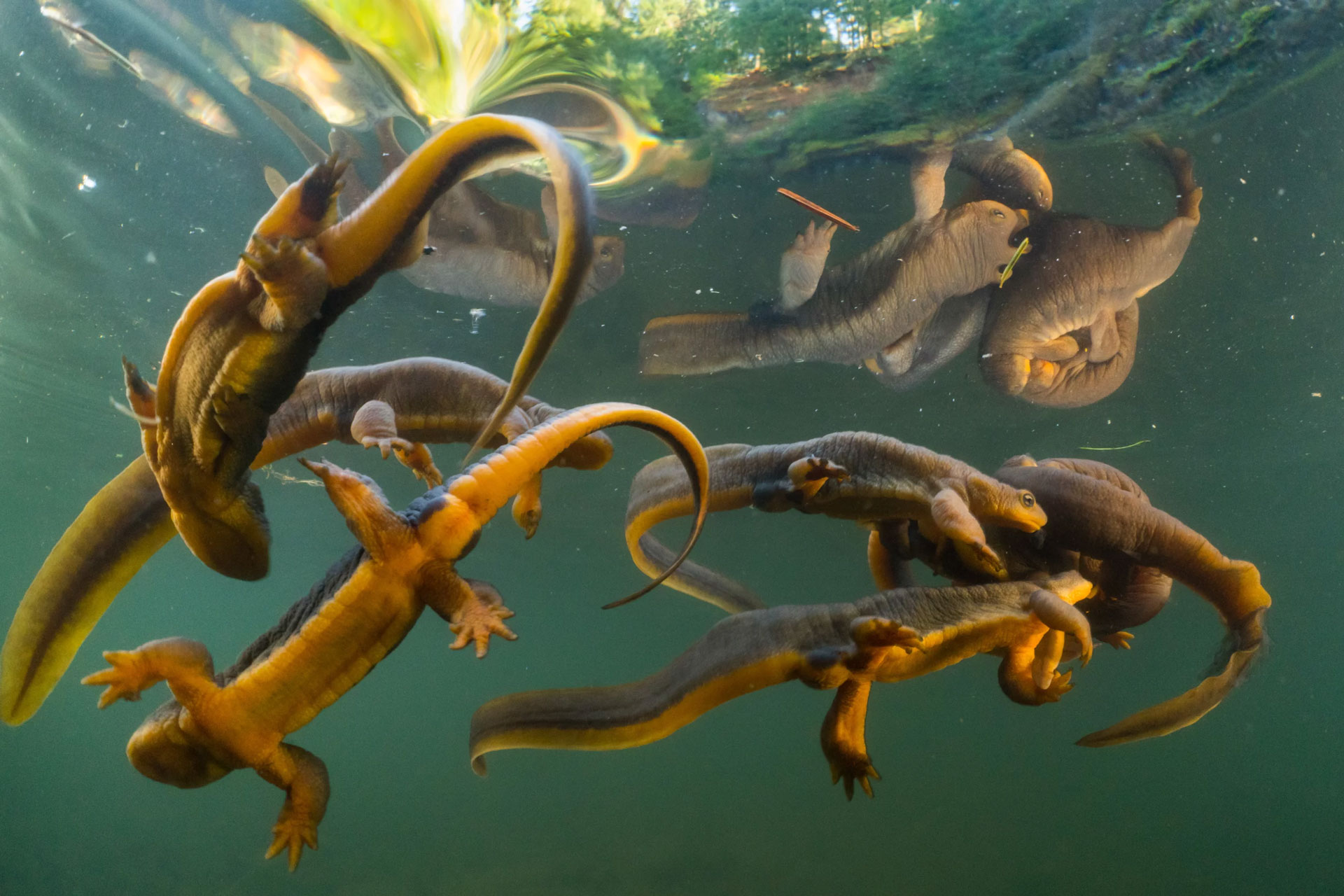 A group of rough-skinned newts interact with a breeding pair of newts in a small pond in Oregon’s Coast Range Mountains.
A group of rough-skinned newts interact with a breeding pair of newts in a small pond in Oregon’s Coast Range Mountains.
What do you want people to come away with after looking at these images?
As the climate and planet continue to change, many people are trying to understand and grasp how the natural world is connected to their everyday lives. So often, the question is asked, what is the value of an individual species? Or what is the value of biodiversity? By creating storytelling imagery that helps audiences recognize the relevance of forest life, my hope is that this project will engage and inform audiences about the importance of old-growth ecosystems in the Pacific Northwest. Bringing to attention the individual species and relationships within ecosystems that play a role in maintaining our planet, my goal is to spark curiosity and wonder, encouraging people to want to learn more.
 Biologists from Oregon State University survey for trout and amphibians in the H.J. Andrews Experimental Forest. Tucked in the Cascade Mountain Range in western Oregon, this long-term ecological research site is one of the most studied old-growth ecosystems on the planet and has laid the foundation for how we understand forests worldwide.
Biologists from Oregon State University survey for trout and amphibians in the H.J. Andrews Experimental Forest. Tucked in the Cascade Mountain Range in western Oregon, this long-term ecological research site is one of the most studied old-growth ecosystems on the planet and has laid the foundation for how we understand forests worldwide.
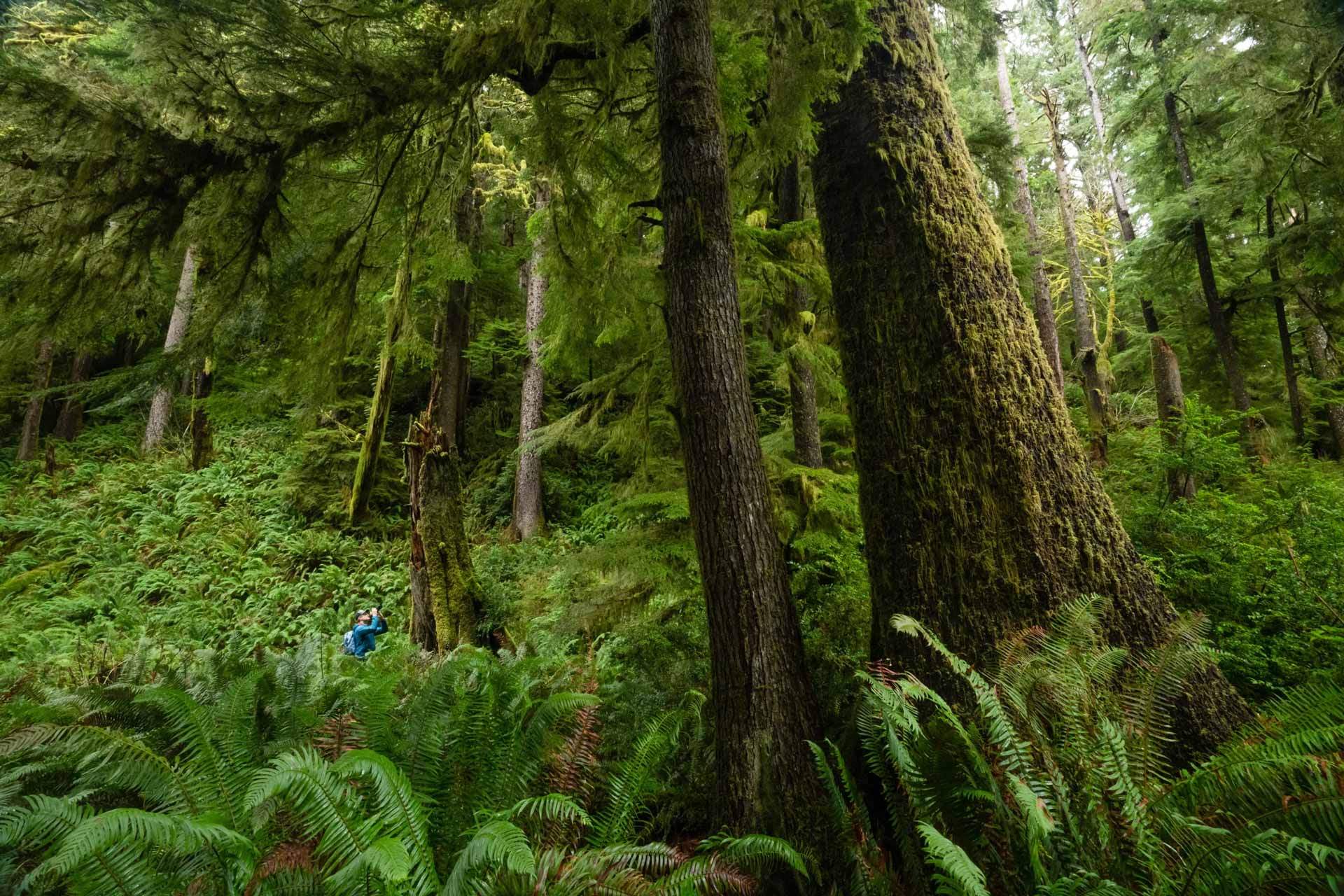 A hiker photographs a large western hemlock in an old-growth forest in Oregon’s Coast Range. Coastal forests in the region have some of the highest carbon-storing potential of any forest type in the world.
A hiker photographs a large western hemlock in an old-growth forest in Oregon’s Coast Range. Coastal forests in the region have some of the highest carbon-storing potential of any forest type in the world.
As our demand and impact on forests continues to grow worldwide, I believe images and stories of the environments and species affected will play a critical role in visually connecting forest ecosystems to their would-be stewards. Understanding the importance of biodiversity and how forests function is a critical part in creating that connection.
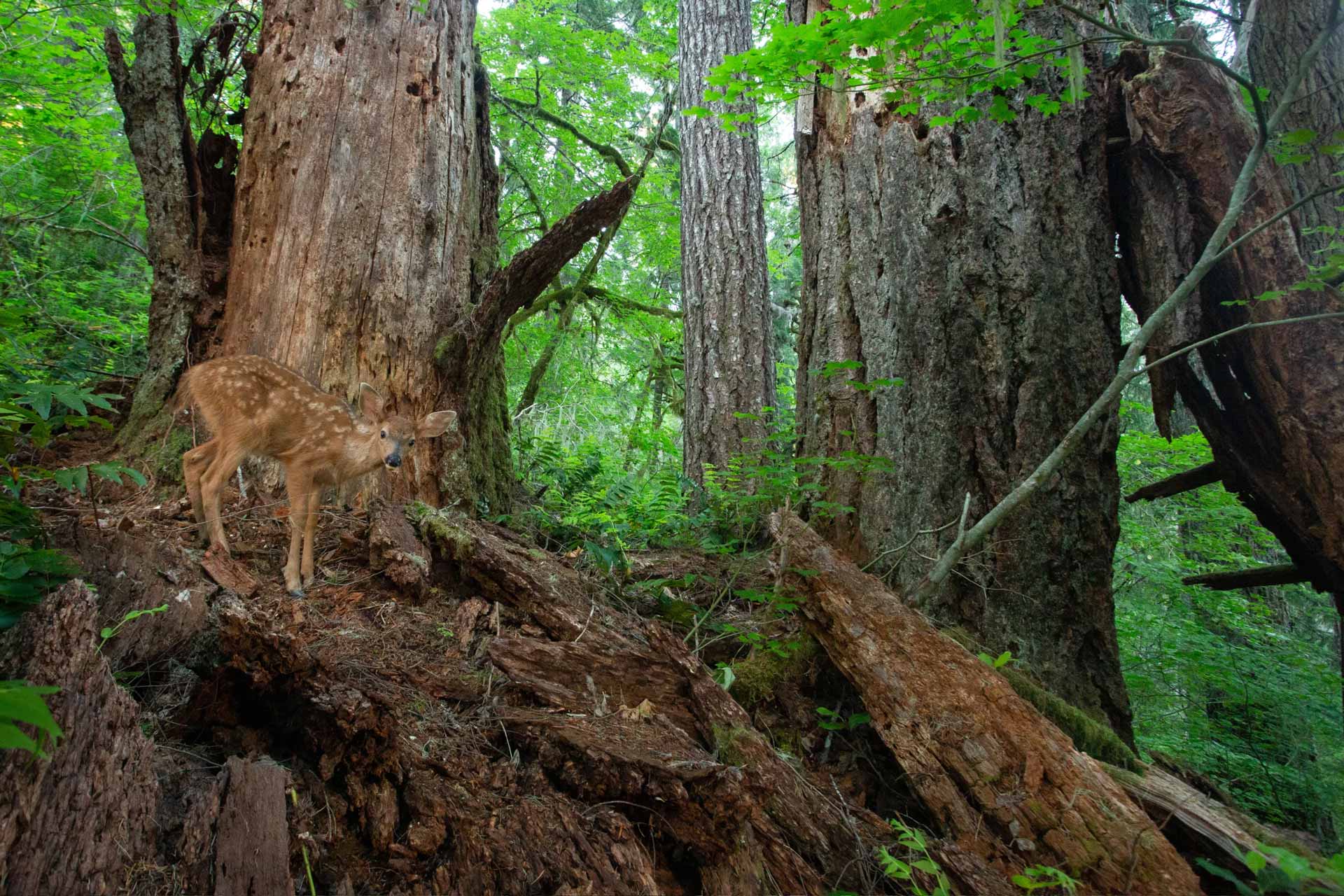 A young black-tailed deer blends in among a pair of decomposing Douglas fir snags in Oregon’s Coast Range. Providing critical habitat for over one hundred species, snags help create locations for nesting, shelter and foraging, and are an incredibly important component to healthy old-growth ecosystems.
A young black-tailed deer blends in among a pair of decomposing Douglas fir snags in Oregon’s Coast Range. Providing critical habitat for over one hundred species, snags help create locations for nesting, shelter and foraging, and are an incredibly important component to healthy old-growth ecosystems.
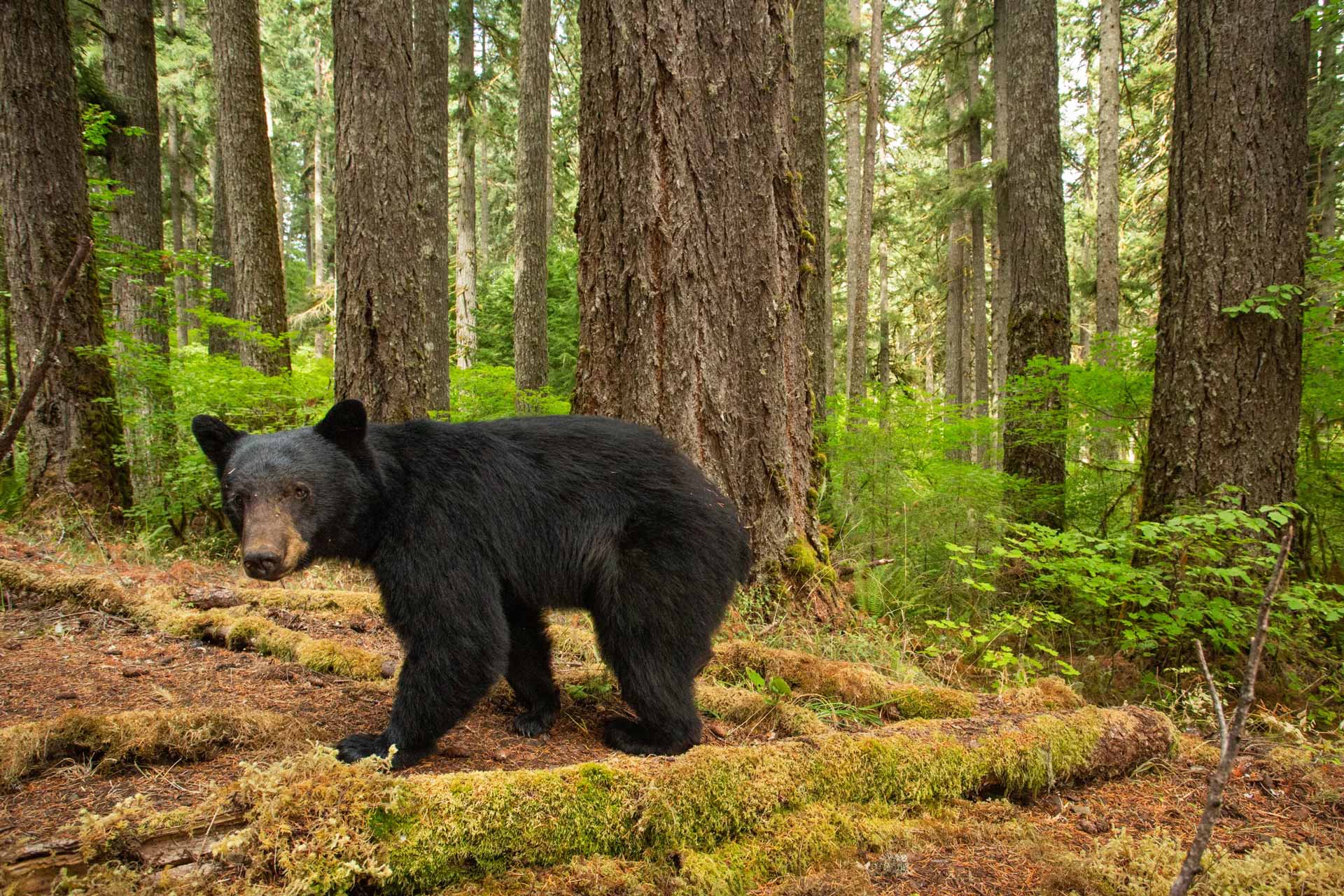 Navigating a maze of giant Douglas firs, a large black bear explores its home in one of the last old-growth stands left in Oregon’s Coast Range. These towering trees provide important habitat for bears, who use tree cavities as denning sites for their young and for hibernation.
Navigating a maze of giant Douglas firs, a large black bear explores its home in one of the last old-growth stands left in Oregon’s Coast Range. These towering trees provide important habitat for bears, who use tree cavities as denning sites for their young and for hibernation.
David Herasimtschuk is a documentary photographer whose work focuses on forest and freshwater environments. You can find more of his photography on his website, DavidHerasimtschuk.com, and on Instagram, at @davidherasimtschuk.

By submitting your comments, you hereby give AZPM the right to post your comments and potentially use them in any other form of media operated by this institution.